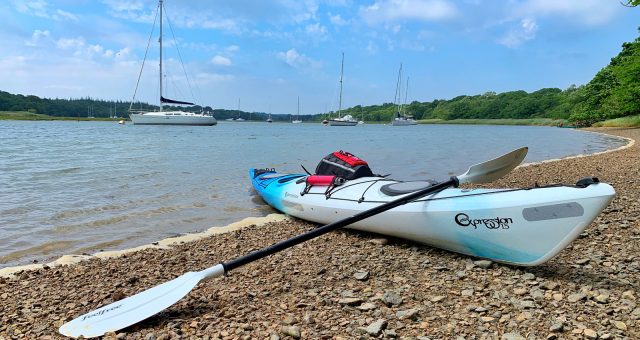
Guide 4 – What to consider when looking for a paddle?
Here I will discuss the importance of choosing the right paddle to get the most from your paddling and reduce the risk of injury. Paddling long term with a paddle that’s too big will lead to sore wrists, elbows and shoulders. Just as tennis players get tendonitis in the elbow, paddlers get this injury in the wrists. If your paddle is too small, your rate of paddling is always too high and you’ll get tired. So what should you consider when looking for a paddle?Just like boat selection, it will reflect the type of paddling you do, and your physical size will help you make the right decision. The main features to consider are; length, shaft size, blade shape and the construction (weight).
Ultimately, not all of these things matter to a beginner, but the paddle you choose will partly dictate your style of paddling and the likelihood of injury.
If your paddle is too small, your rate of paddling is always too high and you’ll get tired.
Paddles are made up of two main important parts, the shaft and the paddle blade.
White Water Paddles
White water paddles are relatively short giving you a high tempo paddle. They feature a big power face for maximum power transfer. They’ll give you lots of power going forwards and backwards.
Sea Kayaking Paddles
Features a long shaft for more leverage and lower tempo of paddling. Longer and slimmer blades for a lower paddling action, as well as a long shaft for extra reach in turning the boat.
Performance Paddles
These are generally long light paddles with winged blades to grip the water and apply the maximum amount of power. Designed to repeat the same forwards stroke and nothing else.
Paddle Basics
Paddles are made up of two main important parts, the shaft, and the paddle blade. These two parts can be made of different materials and it is important to know how these can affect our paddling. But, before we start getting carried away with shiny materials, we need the right length!
Paddle Length
As a general rule, smaller paddlers should use shorter blades. The type of kayaking will have an impact when we need to perform a higher rate of strokes e.g. white water paddling, where we are always changing direction or changing our speed, it will be easier with a shorter paddle. Touring along the coast, eating up the miles, will be easier with a longer paddle.
White Water and Freestyle Paddles average – 180-200cm long.
Sea, Touring and Recreational Paddles average – 160-230cm long.
Paddle Shaft
The shaft is the part of the paddle that you place your hands on. Most people don’t realise that there is actually a lot that goes into designing a paddle shaft.
Shaft type – Straight or bent/cranked shaft. Straight shafts are more common, lighter, and cheaper. Bent shaft paddles put much less stress on your wrists, but are more expensive.
Shaft size – As hand size increases, so should the thickness of the paddle shaft. The choice here is primarily based on comfort.
Paddle Blade Shape
As a general rule, the stronger and bigger you are the larger blade you can paddle with.
Size – As well as our stature we will use chunkier paddles as we paddle with a more vertical stroke ie. slalom, white water. When we relax and paddle with a lower angle we can have a longer, narrower blade ie. sea kayaking, touring.
Symmetrical or Asymmetrical
This depends on whether both blades are identical (Symmetrical) or a mirror image of each other (Asymmetrical). The main points are more efficient with an asymmetrical design but they will be more expensive.
Feather
The feather of a paddle refers to the angle that each blade is offset from the other. The feather means the blade waving in the air each time we take a stroke does not catch in the wind. Some touring or sea paddles come as splits (two parts). These are great for storage, but also allow you to set your own angle of feather to paddle with.
Construction
Paddles are made from a variety of materials, with the cheapest being plastic blades with metal shafts. They will get more expensive, but stronger and lighter, as we use fibreglass and carbon fibre. Some Greenland sea and canoe paddles are still lovely, usually made from wood. The lighter the paddle the stiffer they have to make it, putting extra pressure on your joints, so it’s even more important to have the size and length right if you buy a carbon fibre paddle. Using a lighter paddle makes it less work and strain, so it can be worth the extra cost.
Our top tip
Match the boat to what you’re keen to do. Will you paddle in rough or flat water? Short or long distances? Will you be in a rush or relaxing? It’s great to try lots of different boats to help you decide which bits you really enjoy. Clubs, centres, friends and events are great ways of getting access to all the boats.
Go to guide No 5. – What to take kayaking?

